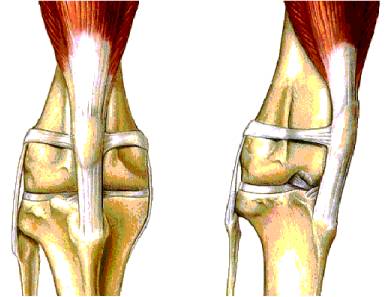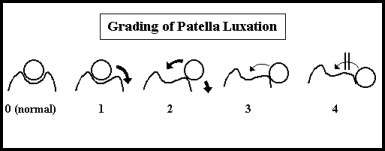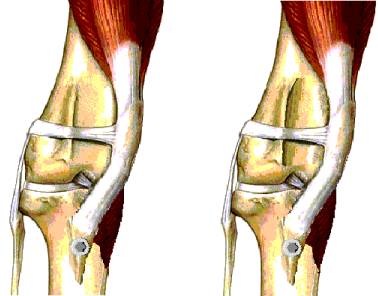 |
|
|
|
Severity of MLP is determined by palpation of the knee joint and is classified from 0 (normal) to 4 (severely affected) as follows; |
|
| Grade 0 |
Normal |
| Grade 1 |
the patella can be pushed out of the groove but spends most of time in the groove |
| Grade 2 |
the patella approximately half the time in the groove and half the time out of the groove. It can easily be manipulated in or out but has no tendency to stay in either position. |
| Grade 3 |
the patella spends almost all the time outside the groove and with pressure can be pushed back into the groove. |
| Grade 4 |
the patella spends all the time outside the groove and even with pressure the patella cannot be pushed back into the groove. |
|
|

|
|
|
TREATMENT
Grade 1 and early grade 2 MLP may only require medical treatment for pain and minor swelling within the knee joint. Mid-stage grade 2, grade 3 and grade 4 are best corrected with surgery. The three common surgical procedures are described as follows;
Tibial Crest Transposition (TCT). The patella tendon attaches to the top of the tibia. This area of bone is surgically separated from the shaft of the tibia and repositioned on the outside of the tibia. The bone is secured by pins and wires or a surgical screw. Recovery time to normal walking is 6-8 weeks although most dogs are weight bearing within 1 to 2 days.
Wedge Recession Trochleoplasty (WRT). The groove in the femur where the patella lies is surgically deepened by cutting out a wedge shaped section. |
|

|
|
|
Lateral ligament placement. This involves placing nylon bands through the patella and its tendon and anchoring them to the outside of the knee joint.
Any, a combination of, or all of the above techniques may be used to repair MLP. This decision is made during surgery and depends on the size of the dog, degree of luxation, conformation of the knee joint and the presence of osteoarthritis.
The prognosis following surgery is good to excellent in at least 95% of cases. Those cases that have a poorer prognosis are those with poor knee conformation, grade 3 and 4 luxations and those knees with osteoarthritis. |
|
 |
|
© Dr Steven Metcalf BSc BVMS (Hons) MSc MACVSc
Applecross
Veterinary Hospital
Perth, Western Australia |
|

|
|
LINKS TO ARTICLES ON OTHER SITES |
| |
|
|
|
|
| |



